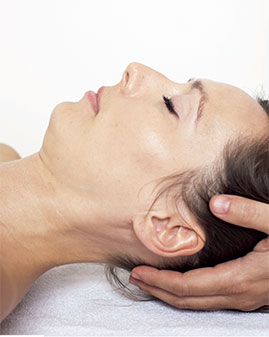Natural Therapies - Osteopathy

Audrey Trigg is a member of the Osteopathic Council of Ireland and set up her own practice, Dublin Osteopathy, in 2010. She uses a broad range of osteopathic techniques, including cranial osteopathy, to help patients of all ages. She has a particular interest in women and children’s health and helps people with complaints such as back pain, neck pain and headaches.
Osteopathy is a form of manual therapy which recognises the important link between the structure of the body and the way it functions. The name ‘osteopathy’ literally translates as ‘bone disease’, but it’s not just about bones. Osteopaths focus on how the skeleton, joints, muscles, nerves, circulation, connective tissue and internal organs function as a holistic unit. Osteopathy aims to address the cause of your problem.
Osteopaths have a highly developed sense of touch (called palpation). Using palpation along with skilled evaluation, diagnosis and a wide range of hands-on techniques, osteopaths can identify important types of dysfunction in your body. The gentle approach of osteopathy makes it suitable through all stages of life, from infants and children through to pregnant women and the elderly.
Osteopathic treatment uses techniques such as stretching and massage for general treatment of the soft tissues (muscles, tendons and ligaments), along with mobilisation and manipulation of specific joints and soft tissues. All these techniques aim to restore balance and function to the body allowing it to be better able to deal with the problems it is experiencing.
Osteopaths are highly trained and need a four- to five-year full-time degree. The training covers an in-depth study of anatomy, physiology, pathology, differential diagnosis and general medical diagnostic techniques, as well as specific osteopathic diagnosis and treatment techniques. Your osteopath is also trained to recognise conditions that may need further investigation or medical treatment and will refer you appropriately.
The most common complaint most osteopaths would see is back pain. In fact, research shows that back pain will affect up to 80% of us at some time in our lives. There are many different causes of back pain – falls, car accidents and lifting heavy objects are some of the more obvious ones.
Quite often back pain can just begin suddenly with a simple movement, such as bending over or stretching to reach for an object.
In a healthy individual, simple everyday movements should not cause pain. In these cases, an osteopath will often find strain or restriction at the site of the pain as well as in other apparently unrelated areas. When the body is already adapting to mechanical stresses, it has a reduced ability to tolerate additional strain. So that simple movement of bending forward has overloaded the body’s ability to compensate and resulted in a muscle, ligament or joint strain.
Osteopaths aim to address the strain patterns present at the site of pain, as well as other related areas that may be contributing to the pain, to relieve symptoms and prevent recurrence. This is the holistic nature of osteopathy – the whole body works as a unit and needs to be assessed and treated as such.
The number of treatments needed for this result varies in each individual case. Generally you would expect to see some changes in your symptoms after one or two visits, but some long-term or chronic conditions may require a longer course of treatments.
As well as back pain, osteopathy can give you relief from tension headaches, pregnancy-related pain (SPD, back pain, rib pain), unsettled babies, sports injuries, whiplash injuries, sciatica, muscle tension, shoulder and neck pain, repetitive strain injuries, arthritic and joint pain, knee and ankle pain.
For your safety, always make sure your osteopath is a member of the Osteopathic Council of Ireland (www.osteopathy.ie [link to be "nofollow"]). Membership ensures that osteopaths have met the council’s strict criteria on education standards, have indemnity insurance and that they comply with continuing professional development guidelines.
CASE CONFIDENTIAL:
'My back pain is a thing of the past with osteopathy'
Hilary* from Cork
I had a baby in 2008 and then another one in 2009 and as a result I have suffered from intermittent back trouble – sometimes my lower back and other times my upper back. I was spending a fortune on physiotherapy which would help for a while but then my back would go again and I felt that I wasn’t really solving the problem.
I wanted to address the issue properly so I tried osteopathy. I had three or four sessions and immediately noticed a difference.
My therapist was more interested in how my bones work in relationship to each other, she also recommended I take up pilates and gave me tips for how to reduce the number of visits I would need to make to her.
She recommended a deep tissue massage before a session as this would really help her to solve my back problems. It was very painful but it really loosened up my muscles and helped her to work on my back.
An osteopath will lean into your back and you hear your bones crack – I feel 10 years younger when I come off the table.
One time she was able to see one of my legs was longer than the other just by the way I was walking, and help to address that imbalance.
I haven’t had to visit the osteopath anywhere near as many times as I was going to the physiotherapist. I now go back every six months or so to make sure I don’t have any underlying problems.
For more information check out www.dublinosteopathy.com
Contact Audrey Trigg at Tel: 01 679 8589 or audrey@dublinosteopathy.com
* Not her real name
Click here to read more Rude Health Magazine natural therapies articles.
Click here to read the latest issue of Rude Health Magazine.